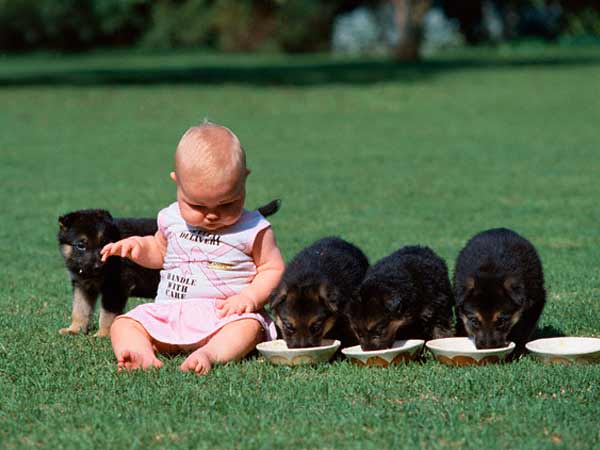Keeping dogs with kids at home
needs juggling quite often. Both dogs and children need to be supervised
and trained to keep them safe from each other.
Dog & Child

While we see gorgeous photos of children hugging dogs, cats and horses and
pets loving children by licking them or staring at them lovingly, it is
not so harmonious relationship at home. Especially when the child enters
the toddler-hood and learns to crawl and walk, pets may look at your
child differently. While natural hunting instincts of a large or
medium-sized dog may lead him to think that the small moving creature is
a prey, smaller dogs may be afraid of the child. They tend to run away
from the children. Parents should train the dog to sit or stay near
them, while the child is on the prowl by rewarding him with caresses and
pats. Trained dogs normally never hurt the child until it is for
self-defense but still supervised interaction between your child and
dogs is necessary to make them both comfortable with each other.
Teach your child to respect your dog and not to tease it too hard or
too often. Keep your child away from exploring your dog's possessions
such as its toys, food or water bowl and its litter box and they should
know that biting or kicking the pet may hurt it. Discourage them to
twist or pull your dog's ears and tails, pinching it and poking fingers
or other sharp objects into its eyes. Small and toy dogs often suffer in
the hands of the children who like to kick them off or scream in its ear
and do not let it sleep properly. Thus, special should be taken to save
it from children's tricks. Children need to be taught that pets are not
toys and that they feel the hurt too and that they can hug them and pet
them gently but should not cause them pain.
It is important that a dog should know its place in the family
hierarchy. Dog may feel rejected with a new arrival in home or may like
to lick the child and be licked in return. But supervision is always a
must when your child and your dog are together. If it is not possible,
you may place the child in the playpen for the short period when you are
not around. By the toddler age, child is old enough to learn the
acceptable and non-acceptable behavior with the dogs and how to interact
with them. Dogs may be allowed to enter the nursery but they must be
taught to hold a down-stay. Kids find dogs as funny playmates while dogs
take them to be littermates. Though, your dog may tolerate a little bit
of pulls and yanks, too much of naughtiness may set him against the
child. Teach the child and the dog to play together interactive games
such as 'Fetch' and 'Hide and Seek' that does not involve rough play.
Provide the dog with a quiet secluded play to rest at peace when your
kids' friends are visiting home. Older children may help to take care of
the dog such as feeding and training them, as they are more consistent
and playful. They may walk the dog inside the yard and do chores for the
dog, according to their age, ability and interest. It will make your
child responsible too. However, don't overlook your own duty towards the
dog as the child may be careless and may not be able to avoid proper
attention to the dog. Teens are more self-centered and may not pay
attention to the dog and so you need to pay special attention to your
pet to keep it from feeling neglected.


